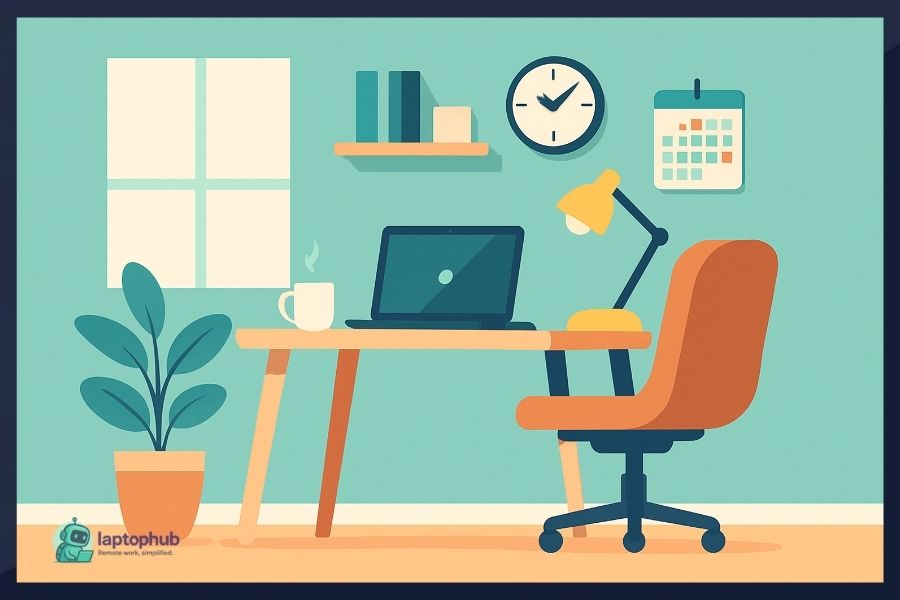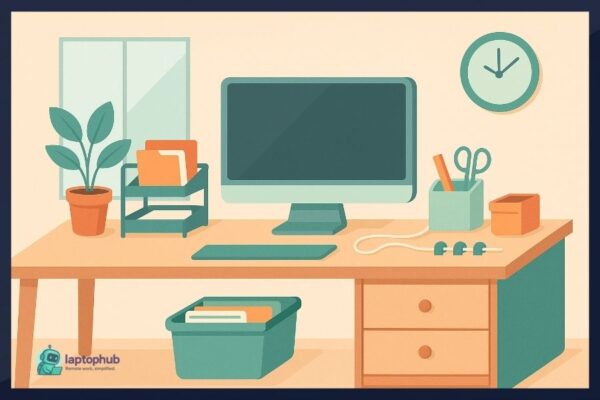Working from home gives you freedom—but without the right environment, it also brings distraction, discomfort, and burnout. Most people don’t realize how much their desk, chair, lighting, or layout affects their performance. Whether you’re in a tiny apartment or have a full room to work with, building an intentional home office setup transforms how you work and how you feel doing it. This guide isn’t just about where to put your laptop—it’s about creating a space that helps you thrive.
💡Key takeaways:
- Your home office setup directly affects your productivity, focus, posture, and mental clarity.
- Choosing the right space, furniture, lighting, and tech is key to building an effective work-from-home environment.
- Ergonomics and organization are essential for long-term comfort, efficiency, and health.
- A great home office doesn’t require a big budget—what matters is intentional design and continuous improvement.
Why Your Home Office Setup Matters
A good setup isn’t just about aesthetics—it affects your energy, posture, focus, and long-term health. According to Harvard Business Review, how you design your workspace influences your effectiveness and how you feel about your work.
Benefits of a proper setup:
- Helps reduce burnout and fatigue
- Reduces physical strain (especially back, neck, and wrist pain)
- Improves focus and task management
- Establishes clear work-life boundaries
Step 1: Choose the Right Spot in Your Home
You don’t need a dedicated room—but you do need a dedicated space. Choose a spot that lets you focus, feels comfortable, and separates work from the rest of your life.
Things to consider:
- Noise level: Avoid high-traffic or shared spaces.
- Privacy: Ideally, pick a spot where you won’t be interrupted.
- Lighting: Natural light is a bonus—set up near a window if you can.
- Ventilation: You’ll be sitting here for hours. Make sure it’s not stuffy.
Tip: Even in a studio, use a bookshelf, curtain, or folding screen to separate your desk from your bed or sofa.
Step 2: Pick a Desk That Fits Your Needs
Your desk is your foundation. It should support your work—not limit it.
Recommended desk types:
- Standing desks: Boost circulation and energy. Popular options include ErGear and Monomi.
- Compact desks: Great for small spaces. Try the Claiks Electric Standing Desk or a Portable Rolling Desk on Wheels.
- L-shaped desks: Ideal if you use dual monitors or need more surface area. See options from SHW.
Size tips:
- Minimum depth: 24″
- Width: 40″–60″ for monitor setups
- Surface: Look for scratch-resistant laminate or wood veneer
Step 3: Get a Chair That Won’t Wreck Your Back
This is your most important investment. A poor chair = pain, distraction, and long-term damage.
Features to look for:
- Adjustable seat height
- Lumbar support
- Tilt and recline tension
- Adjustable armrests
- Breathable mesh or fabric
Top ergonomic chairs:
Step 4: Set Up Your Monitor, Keyboard, and Mouse Ergonomically
Good ergonomics prevent strain and fatigue.
Monitor setup:
- Top of screen = eye level
- 20–30 inches from your eyes
- Use a monitor riser or VESA mount if needed
Keyboard + mouse:
- Keep wrists straight and level with elbows
- Use an ergonomic keyboard like the Logitech ERGO K860
- A vertical mouse (like the Logitech MX Vertical) can reduce wrist strain
Tip: A wrist rest can help with comfort—but only if your keyboard height is already correct.
Step 5: Don’t Ignore Lighting
Lighting affects your eyes and your energy. Poor lighting causes headaches, fatigue, and reduced focus.
Ideal lighting setup:
- Natural light near a window (but avoid glare)
- Task lighting like the Airlonv for adjustable brightness
- Color temperature: Use 4000K–5000K (cool white) to stay alert
- Avoid harsh overhead lighting—soft, indirect light is better
If you’re on Zoom calls often, consider a soft monitor clip ring light for even lighting.
Step 6: Add the Right Tech Tools
You don’t need the most expensive gear—but your tech should support your workflow without friction.
Must-have devices:
- Laptop/PC: Aim for 16GB RAM and SSD storage
- Second monitor: Increases productivity by up to 42% (study)
- Docking station: Like the Anker 577 USB-C Docking Station
- Webcam: Try the Logitech C920
- Headphones with mic: Sony WH-1000XM5 or Jabra Evolve2 65
Step 7: Manage Cables Like a Pro
Cable mess adds stress. Tidy up with:
- Cable trays like the Under Desk Wire Organizer by Scandinavian Hub
- Velcro ties or cable sleeves
- Labeling for power bricks and chargers
Use a vertical power strip or charging station to consolidate outlets.
Step 8: Stay Organized and Clutter-Free
Clutter isn’t just ugly—it distracts your brain.
Tools for organization:
- Desktop drawer
- Monitor stands with storage
- Wall shelves or pegboards for vertical storage
- Inbox trays for paper or notebooks
Follow the “touch it once” rule: if you pick something up, put it away immediately or act on it.
Step 9: Build a Setup That Works in Small Spaces
You don’t need a huge office to have a great setup.
Smart ideas for limited space:
- Use a wall-mounted desk or fold-down table
- Turn a closet into a mini office (aka “cloffice”)
- Use vertical space for storage
- Choose multifunctional furniture (storage bench, file cabinet that doubles as a side table)
Step 10: Personalize Without Overdoing It
Your office should feel like yours, but not like a toy store.
Add personality with:
- One or two framed prints or a corkboard
- A live plant (snake plant, pothos, or ZZ plant)
- A small essential oil diffuser
- A lamp with warm light for late evenings
Avoid excessive gadgets or cluttered inspiration boards—it can get overwhelming fast.
Step 11: Stay Focused and Avoid Burnout
Even with the best desk, you can’t be “on” all day. Build structure into your day.
Focus hacks:
- Pomodoro method: Work 25 minutes, rest 5. Apps like Focus To-Do help track it.
- Task batching: Group similar tasks to reduce context switching
- Noise apps: Use Noisli or Coffitivity for ambient focus
- Time-blocking calendar: Treat focus time like meetings—non-negotiable
Also, drink water, stretch, and take real breaks. You’re not a machine.
Final Checklist ✅
- A comfortable, distraction-free location
- Ergonomic chair and desk at proper height
- Natural and task lighting
- Monitor at eye level, keyboard/mouse at elbow level
- Tidy cable setup
- Organized supplies and tech
- Personal touches (not clutter)
- Focus tools and structured routine
Where to invest: Chair, monitor, lighting
Where to save: Desk, keyboard, organizers
Home Office Setup FAQs
What is the best home office setup for productivity?
The best setup includes an ergonomic chair, natural and task lighting, a clutter-free desk, and tech that supports your workflow—like a second monitor and noise-canceling headphones.
How can I create a home office in a small space?
Use compact desks, vertical storage, and room dividers to carve out a defined workspace—even in bedrooms or studio apartments.
Is a standing desk worth it for a home office?
Yes, standing desks can improve circulation, reduce back pain, and increase energy, especially if you alternate between sitting and standing.
What should I prioritize when building a home office on a budget?
Focus on an ergonomic chair and good lighting first, then upgrade your desk, monitor, and accessories over time.
How do I make my home office look professional for Zoom calls?
Use a clean, uncluttered background, position yourself near natural light, and use a webcam with clear resolution and even lighting.
Final thoughts
You don’t need to buy everything at once. Start with what you have. Upgrade in phases. And check in every few months: what’s working? What’s frustrating?
Your home office isn’t just where you work—it’s part of how you live. Make it support you, not fight against you.




